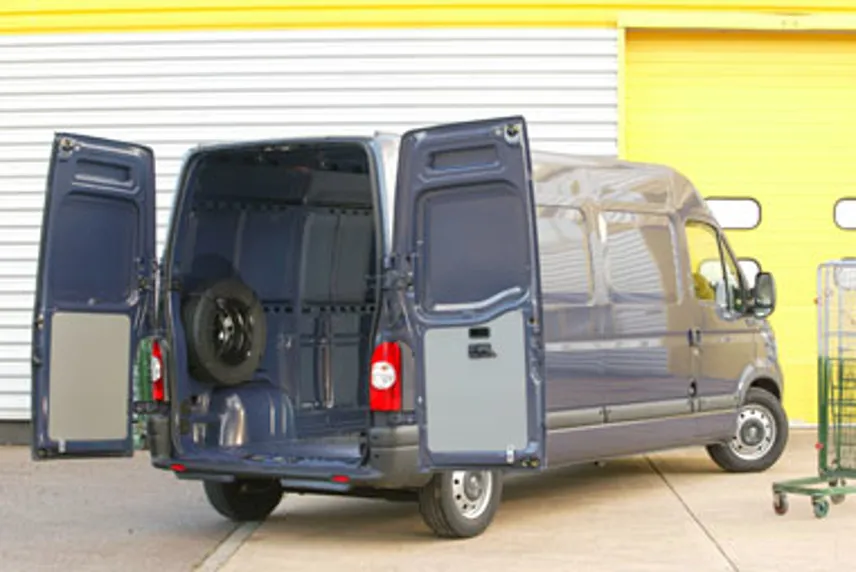Review
The driver’s seat adjusts for rake and height but the steering column doesn’t move.
There is no need for it to, however, as a comfortable position should be easily obtainable for any height and weight.
Meanwhile, there are plenty of cubby holes, including large cola bottle bins in each door and there is a handy holder for sheaves of A4 paper in the dashboard’s centre, along with a document clip.
In the roof there are grab handles both on the passenger side and in the centre so the occupants don’t get too matey with each other on fast bends, while there are coat hooks on both sides which could double up as Chinese takeaway holders – a small but important addition.
In SE format, the Interstar comes with a CD?player and ABS brakes as standard, along with a driver’s airbag, electric windows and mirrors and a reversing sensor.
Optional extras include a passenger airbag at £220, a climate pack featuring air conditioning and heat reflective windscreen at £750, a technology pack with sat-nav, pre-telephone wiring and cruise control at £1,600 and a glazing pack with glass bulkhead and rear doors at £200.
In the back
Entry into the rear in standard vans is by a single sliding door on the nearside or unglazed rear doors that open to 180 degrees.
A second sliding door can be bought for an extra £300 while 270 degree rear doors cost an extra £225.
The cargo area of our test van didn’t have any protection and was already showing signs of scuffing and scraping.
Any disposal expert will tell you that plywood cladding is a must. It will pay for itself and more at selling time when your van’s rear end will be revealed to be sparking and spotless.
Our long wheelbase model featured eight load lashing eyes in the floor, along with two lights which really weren’t man enough to light up the cavernous interior.
It’s a fault many larger panel vans suffer from.
Meanwhile the spare wheel is mounted over the nearside wheel arch, thus taking up cargo space.
On the road
The Interstar’s 1.9-litre and 2.5-litre engines come courtesy of Renault – and are both cracking units.
But this big, powerful 3.0-litre giant is Nissan’s own and what a wonderful unit it is.
It doesn’t rattle and roar in the morning like old style diesel units used to, but its common rail technology gives a quite meaty thrum that promises enough power and more even under full load.
At 136bhp and 236lb-ft of torque it isn’t the most powerful van on the road – that honour goes to the Volkswagen LT 158, with 158bhp and 244lb-ft of torque.
But those extra cubes in the Nissan seem to give it a quiet air of superiority that the VW lacks.
The Interstar’s steering wheel is almost horizontal, unlike in some vans which have the wheel tilted at an angle to give a more car-like feel.
Nissan no doubt feels that the kind of driver using this van will be a professional who is well used to commercial vehicles.
The dash-mounted gearstick snicks into place smoothly and clutch and power steering are both nicely weighted.
In fact once out on the road, the sheer bulk of this van can be largely forgotten.
That standard reversing sensor is a Godsend at parking time as this vehicle is no small beast.
Quite often it means you don’t need a banksman to help you into those awkward little spaces.
There are six gears to choose from and such is the huge amount of torque on offer that the driver can almost pick any gear at any speed.
Meanwhile, oil changes only come once every 24,000 miles, glowplugs are rated to last for 120,000 miles and timing chains need to be replaced only at 240,000 miles, making for low running cost figures.
Verdict
The Nissan Interstar is a star among heavyweights and will bring a smile to any driver’s face, with its powerful motor and upmarket interior.
If I was a van fleet operator choosing this vehicle my only question would be ‘Can I get away with one of the smaller engines to save cash?’
For example, the 2.5-litre unit in this size of vehicle offers either 100bhp or 115bhp at £19,717 or £20,917 to the 3.0-litre’s £22,117.
















